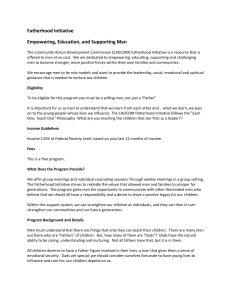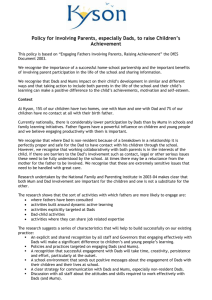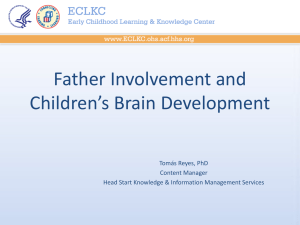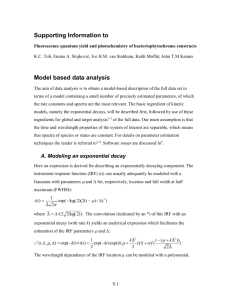developing meaningful parental involvement
advertisement
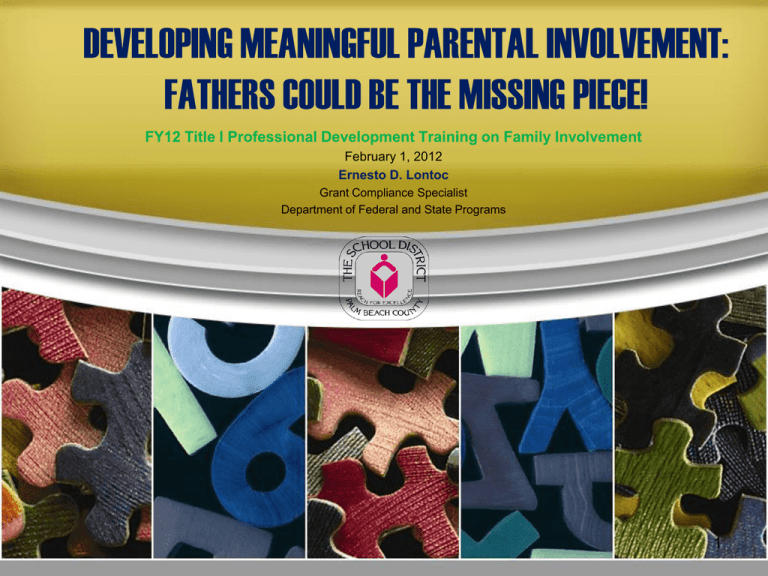
DEVELOPING MEANINGFUL PARENTAL INVOLVEMENT: FATHERS COULD BE THE MISSING PIECE! FY12 Title I Professional Development Training on Family Involvement February 1, 2012 Ernesto D. Lontoc Grant Compliance Specialist Department of Federal and State Programs 1 It’s the law! • The NCLB legislation requires that local educational agencies are to make sure that parents are fully involved so that “programs, activities, and procedures shall be planned, and implemented with meaningful consultation with parents of participating children.” (ESEA, Section 1118(a)(1) • Parent involvement is mentioned over 300 times in the law! What is parental involvement? • Parental involvement is the participation of parents in regular, two-way, and meaningful communication as it pertains to academic learning and other school activities. This includes ensuring that: Parents play an integral role in assisting their child’s learning Parents are encouraged to be actively involved in their child’s education at school. Parents are full partners in their child’s education and are included, as appropriate, working in decision making and on advisory committees to assist the education of their child. Why parent involvement? • TEACHERS SAY… – 67% of teachers surveyed (Public Agenda, 2003) believed that their students would perform better in school if their parents were more involved in their child’s education • PARENTS SAY… – 72% of parents say children of uninvolved parents sometimes “fall through the cracks” in schools (Johnson & Duffett, 2003) • RESEARCHERS SAY… – University of New Hampshire found that schools would need to increase per-pupil spending by more than $1,000 in order to achieve the same results that are gained with strong parental engagement (Conway, 2008) 4 SCHOOL BOARD’S STRATEGIC PLAN Offer a world-class education with a Student-First Focus Launch a Family Matters Initiative Ensure a Qualified and Well-Trained Workforce throughout the school district Implement an Efficiency and Accountability agenda Engage in an effective Communications Campaign What is the bottom line? • It is all about students’ achievement! • It is all about equity- all children have the opportunity for a high quality education, with high standards and high quality teachers. Research says….. • When families are engaged, students achieve more, regardless of socioeconomic status, ethnic/racial background, or the parents' education level. (Antunez, 2000) Research says….. • When families are engaged in their child’s schooling, the child will exhibit more positive attitudes and behavior. (Epstein, 2001) • ‘ Research says….. • Students whose families are engaged in their lives have higher graduation rates and greater enrollment rates in postsecondary education. (Henderson and Mapp, 2002) How do fathers compare with mothers in their level of involvement in schools? • In two-parent families, the proportion of children with highly involved fathers is about half of the proportion with highly involved mothers, 27 percent and 56 percent, respectively. • In two-parent families, mothers generally assume primary responsibility for involvement in children’s schools. Fathers make a difference too! Research shows that the more involved dads are, the better the child does in school. • Children learn more. • Perform better in school. • Exhibit healthier behavior. • Fewer behavioral problems. • Higher level of sociability. • Boosts children's confidence. • Children enjoy school more. (www.three4me.com/dadinvolvement.htm) 11 The impact of fathers on cognitive ability and educational achievement Infancy- Fathers who are involved, nurturing and playful with their infants have children with higher IQ’s. 12 The impact of fathers on cognitive ability and educational achievement Toddler- Toddlers with involved fathers go on to start school with higher levels of academic readiness. The impact of fathers on cognitive ability and educational achievement Adolescent- Active and nurturing style of fathers are associated with high verbal skills, intellectual functioning and academic achievement; highly involved fathers had children who were 43 percent more likely than other children to earn most A’s and 33 percent less likely than other children to repeat a grade. When planning for parent involvement…. Identify potential barriers and proactively work together to overcome them. lack of time, economic constraints, lack of transportation, lack of childcare, language, cultural and religious, conflicting schedules etc. Always remember to put yourself in the parents’ shoes! CICYW? Game 16 CICYW? Game RLS •<33 •HF •DNT CMIIW! 17 CICYW? Game CD9 18 CICYW? Game PAL 19 CICYW? Game P911 20 CICYW? Game :I 21 CICYW? Game PRW 22 CICYW? Game PIR 23 CICYW? Game >:( 24 CICYW? Game ily 25 CICYW? Game LMIRL 26 CICYW? Game POS 27 CICYW? Game RX 28 CICYW? Game 9 29 CICYW? Game 99 30 CICYW? Game KPC 31 CICYW? Game BOS 32 CICYW? Game AITR 33 CICYW? Game LIK 34 CICYW? Game PBB 35 CICYW? Game MWAH 36 CICYW? And the winner is…. OMG AFAIK Amy CID BCZ Jessica MHOB TD Jason TMI FNITE 37 Tips on getting fathers involved Create volunteer opportunities and special events for dads. Many dads prefer hands-on projects, as well as “Dad Only” events, school carnivals, sports activities, father-daughter/father-son activities and back-to-school fests. Give it to them straight. Men want clearly defined volunteer roles and expectations. Telling them the what, where, when, and how makes them more likely to volunteer. Tips on getting fathers involved Communicate with dads in the way they want to be reached. Dads want fewer meetings. They prefer to receive communications via email or newsletter, with information presented in bulleted lists or as brief summary points. Seek out male members in the community. Instead of waiting for men to come to you, go where men gather in the community such as ball games, Rotary, Kiwanis or Lions Club, and Sports Grill restaurants. Tips on getting fathers involved No “Dear Parents” letter please….. “Dear Parents” is a code for “Dear Mom”. If you need help from dads, make sure it greets them as “ Dear Dads” and or “ For Dads Only”. Recognize and celebrate fathers involvement. Publicize your successes. Reinforcing men’s contributions creates a positive and welcoming school atmosphere for dads. Every school is unique! Always make sure that your principal is on board for every Dad’s activity that you plan to do! Programs that work Dad’s Day is the First Day In Indianapolis Public Schools, the first day of school is called “Dad’s Day is the First Day”, to persuade dads to bring their children to school. The district continues its efforts throughout the year, encouraging mothers in urban schools to reach out to students male models. The Security Dads In San Diego City Schools, administrators have found that fathers prefer to be given specific tasks and the leeway to do them. The Security Dads was formed, which matches volunteers with spending an hour or more each week patrolling the school hallways, mentoring students, and or providing expertise in school projects. Programs that work R.E.A.D. to Kids Reconnecting Education And Dads, Kansas City, Missouri, is a project of the Urban Fathering Project. This activity helps dads develop a reading program for their children. Parents as Teachers A statewide program in St. Louis, Missouri, this program advocates that parents are children’s first teachers. Programs that work Dads Breakfast Program Dads first have breakfast with their children, then have a dads-only discussion led by parent liaison about the school project, and then rejoin their children to do the classroom/school work and other fixing up in the classroom/school. Walk for Success Team of parent liaison, teachers and dads walk door to door and share information about student achievement test schedule and testing tips. Programs that work What My Father Means to Me; Me and My Dad Essay and Poster Making Contest A powerful strategy that enhances the writing and art skills of students; use students’ work to celebrate Dads in school. Me and He An after school activity that showcases children and their male role models’ hobbies and talents. Programs that work Watch D.O.G.S. (Dads of Great Students) A K-12 program, invites fathers, grandfathers, uncles, or other father figures to volunteer at least one day all day at their child’s/student's school during the school year. Individuals sign up at a kick-off event such as a “Dads and Kids Pizza Night” or “Donuts with Dad” or in the office at any time throughout the school year. The program is overseen by a “Top Dog” volunteer who partners with the school administrator to coordinate scheduling and identify opportunities for Watch DOGS to provide assistance at the school. Watch DOGS volunteers perform a variety of tasks during their volunteer day including monitoring the school entrance, assisting with unloading and loading of buses and cars, monitoring the lunch room, or helping in the classroom with a teacher's guidance by working with small groups of students on homework, flashcards, or spelling. Programs that work The Starlight Cove Elementary’s A.R.M.Y.(Active Responsible Men for Youth) This is an initiative started by the AP Matthew Payner and Guidance Counselor, Michael Kane. It's goal is to provide a time for dads, uncles, grandpas, older brothers or any other significant male role models in a child's life to spend quality time at school with them. A summer event included making a "toolbox" to store question stems to be used to discuss books and a recent event focused on how to initiate and hold meaningful conversations with their children. Father Involvement Resources All Pro Dad, www.allprodad.com Black Star Project, www.blackstarproject.org National Center for Fathering, www.fathers.com National Fatherhood Initiative, www.fatherhood.org PTA, www.pta.org Real Men Cook, www.realmencook.com Three for Me, www.three4me.com U.S. Department of Health and Human Services fatherhood initiative, www.fatherhood.hhs.gov The Reward In short, when parents are involved in education, children do better in school, and schools get better. THNX 49 References Clark, R. M. (1993). Homework-focused parenting practices that positively affect students achievement. In N. F. Chavkin (Ed.). Families and schools in a pluralistic society (pp. 85-105). Albany, NY: State University of New York. Henderson, A., & Mapp, K. (2002). A new wave of evidence: The impact of school, family, and community connections on student achievement. Austin, TX: Southwest Educational Development Laboratory. Mapp, K. (2004). Family engagement. In F. P. Schargel & J. Smink (Eds), Helping students graduate: A strategic approach to dropout prevention (pp. 99-113). Larchmont, NY: Eye on Education. National PTA. (1998). National standards for parent/family involvement programs. Chicago, IL: National PTA. Schargel, F. P., & Smink, J. (2001). Strategies to help solve our school dropout problem. Larchmont, NY: Eye on Education. Cotton, K. and Wikelund, K.R. (1989) Parent Involvement in Education. School Improvement Research Series (SIRS). Based on work sponsored wholly, or in part by the Office of Educational Research and Improvement (OERI), U.S. Department of Education, under Contract Number 400-86-0006. http://www.nwrel.org/scpd/sirs/3/cu6.html. Desmione, L. (1999). Linking Parent Involvement with Student Achievement: Do Race and Income Matter? In Journal of Educational Research, Sept–October (93): 1, 11–30. Epstein, J.L., Coates, L., Salinas, K.C., Sanders, M.G., & Simon, B.S. (1997). School, Family, and Community Partnerships: Your Handbook for Action. Thousand Oaks, CA: Corwin Press. Epstein, J.L. (1992). School and Family Partnerships, Report No. 6. Baltimore: The John Hopkins University Center on Families, Communities, Schools and Children’s Learning. Funkhouser, J. and Gonzales, M. (1997) Family Involvement in Children’s Education: Successful Local Approaches, An Idea Book. U.S. Department of Education, Office of Educational Research and Improvement. Reynolds, A.J., Miedel, W.T., Mann, E.A. (2000) Innovation in early intervention for children in families with low incomes—Lessons from the Chicago Child-Parent Centers. Young Children, March (2000:86). Reynolds, Aurthur J., Temple, Judy A., Robertson, Dylan L., and Mann, Emily A., (2002) Age 21 Cost-Benefit Analysis of the Title I Chicago Child-Parent Centers, Madison, WI: Institute for Research on Poverty, February. Poll: Great Expectations: Multilingual Poll of Latino, Asian and African American Parents Reveals High Educational Aspirations for Their Children and Strong Support for Early Education. New American Media. August 2006. http://www.namethatwhatever.com 50 Dr. Monica Knight: The “Parent-digm” Shift- Part 2- ECTAC Presentation References Goldstine, H. S. (1982). Fathers' absence and cognitive development of 12-17 year olds. Psychological Reports, 51, 843-848. Houston, Blankstein, Cole et al. Leadership for Family and Community Involvement . Hope Foundation, 2010 Nord, C., & West, J. (2001). Fathers' and mothers' involvement in their children's schools by family type and resident status [On-line available: nces.ed.gov/pubsearch/pubsinfo.asp?pubid=2001032. Pruett, K. (2000). Father-need. New York, NY: Broadway Books Sternberg, K. J. (1997). The Role of a Father. New York, NY A New Wave of Evidence: The Impact of School, Family and Community Connections on Student Achievement, Southwest Educational Development Laboratory (2002)

